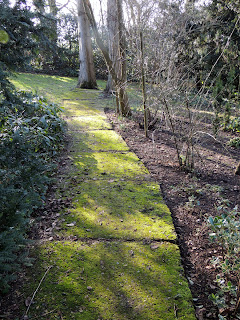MUSINGS FROM THE BOWER 31
What irks me about new handbags is why manufacturers insist on stuffing so much rubbish inside them. I realise they need to give the bag a bit of shape, but often I’ve pulled out so many handfuls of crumpled paper, plastic bags, cellophane and bits of cardboard that it’s beyond a joke. I’m a handbag fanatic, though it took a long while for me to realise it. My mother was content to have just a couple of handbags – a dark one for winter and a light one for summer, but somehow, over the years I’ve acquired lots. Many women throw out old bags as they get new ones, but mine are like old friends and I tend to hang onto them unless they are completely unusable. I feel sad when I need to dump a bag because the straps have snapped or the zip has broken.
When our local TKMaxx store opened, I discovered a treasure-trove of beautiful bags and I’ve found some bargains there – even, on occasion a designer bag. Usually, though, I can’t afford expensive designer bags, and to be honest, many of them look rather boring to me. I know women are meant to yearn for classic Gucci or Louis Vuitton handbags costing hundreds of pounds but I’d much rather settle for a pretty, colourful bag costing a fraction of the price. I love colour. I love kookiness – well, I was fortunate enough to have been a sixties teen, so what else could you expect of me?! Floral bags, furry bags, bags with tassels and chain trims, applique bags, abstract bags and bags printed with quirky designs – I love them.
One of my all-time specials is by Baby Phat, a cream and beige bag decorated with dragonflies, butterflies and flowers, as well as chains, charms and silver links, while another, by Fiorelli, is a super, bright multi-coloured ‘snakeskin’ bag that I love to bits and which goes well with anything. It is magnetic, and has various chains which stick to it. I can fiddle with it for hours. Another of which I’m fond is black but covered in vividly-coloured flowers and features a cane handle. A few years ago, in a boutique in York, I acquired a gorgeous evening bag decorated with dolly-mixture beads, and it came with its own matching purse. York also provided me with a beautiful evening bag in a Regency design, sparkling with crystals, which I bought at the Jane Austen Centre. I wish I could use these more but unfortunately they just don’t hold enough. I do like to lug a lot around with me – my daughter regularly accuses me of carrying around a couple of bricks. I also have a bunny-decorated pink Playboy bag, a couple of bright-colours-on-a-black-background bags by XOXO and a large gold one for when I fancy a bit of bling.
Oh, of course I have plain coloured bags, too – sombre colours for when I need to ‘act my age’ (not often!) – and also bags coloured canary yellow, bright blue, lime and red. My current favourite is a two-tone cerise and deep pink affair with lots of zips and pockets, large enough for me to cram in all my bits and pieces. I still have some of my 1960s/70s treasures – a small beige shoulder bag embroidered with brown beads and featuring a long chain handle, a bright red patent bag that resembles a cube, a purple fabric bag with woollen straps, a faded blue denim bag with plenty of zipped pockets and a bag created from dozens of squares of brightly-coloured leather and suede. One of my bags is made from grey (faux) fur, and reminds me of a cuddly creature so has gained the name of Arthur. I like to use Arthur in cold weather, as he feels comforting! My very first handbag, which I was given when I was eight or nine, was a small light brown leather shoulder bag decorated with pyramids, camels and a swirl of blue sky. I loved it, and needless to say, still have it. A few years later, my aunt gave me my first evening bag, made from black velvet with silver embroidery and a little strap at the back to tuck your fingers under while you were dancing, so you could have your bag with you instead of leaving it on the table.
A quick peek into the handbag I’m using today reveals: a purse, a credit/loyalty card wallet, a wallet containing membership cards for various organisations, pack of tissues, hand gel, mirror, comb, couple of makeup items, keys, phone, Kindle, camera, notebook, three pens, two pencils, address book, asthma inhaler, diary, two pairs of glasses, gloves, ipod, tube of peppermints, perfume, calculator, manicure set and a chequebook (yes, occasionally I still need to write one). Oh, and a worry stone, complete with its own little draw-string bag! When I go on a longer journey, I take my special ‘emergency’ bag, too. This is a clear zip-up pencil case that includes such things as scissors, sticking plaster, safety pins, sewing kit, tape measure, sellotape, short length of string, pencil sharpener, spare notebook, tweezers, shoehorn, small magnifying glass and a minute atlas of the world! With a bit of luck, I can cram it into my handbag.
A hundred years or so ago, women didn’t have such large bags as they didn’t need to carry so much with them, while in Victorian times a tiny reticule, just large enough to hold a few coins, a hanky and a couple of visiting cards was all that a lady needed. How times have changed!





















